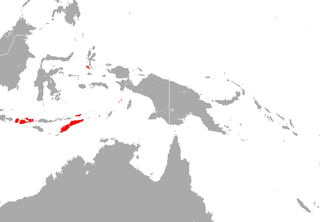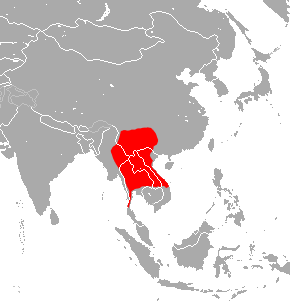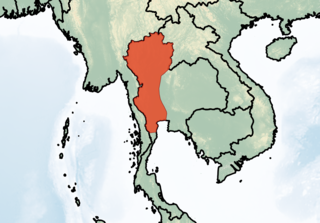
The Philippine pygmy roundleaf bat, also called the Philippine pygmy leaf-nosed bat, is a species of bat in the family Hipposideridae. It is endemic to the Philippines, where it has been recorded on Bohol, Luzon, Marinduque, Negros, Panay, and Mindanao.

The intermediate horseshoe bat is a bat species of the family Rhinolophidae that is very widespread throughout much of the Indian subcontinent, southern and central China and Southeast Asia. It is listed by IUCN as Least Concern as it is considered common where it occurs, without any known major threats.

The Philippine forest horseshoe bat is a species of bat in the family Rhinolophidae. It is endemic to the Philippines.

The insular horseshoe bat is a species of bat in the family Rhinolophidae. It is endemic to Indonesia.

Blyth's horseshoe bat is a species of bat in the family Rhinolophidae. It is found across southern Asia from Afghanistan to Vietnam. The species can be identified from its pointed, bifid sella.

Maclaud's horseshoe bat is a species of bat in the family Rhinolophidae. It is endemic to Guinea. Its natural habitats are moist savanna, caves and other subterranean habitats. It is one of five African microbat species to be listed as endangered by the IUCN. In 2013, Bat Conservation International listed this species as one of the 35 species of its worldwide priority list of conservation. It is threatened by habitat loss.

Marshall's horseshoe bat is a species of bat in the family Rhinolophidae. It is found in Laos, Malaysia, Thailand, and Vietnam.

Pearson's horseshoe bat is a species of bat in the family Rhinolophidae. It is found in Bangladesh, Bhutan, China, India, Laos, Malaysia, Myanmar, Nepal, Thailand and Vietnam.

The large rufous horseshoe bat is a species of bat in the family Rhinolophidae. It is endemic to the Philippines.

The lesser brown horseshoe bat is a species of bat in the family Rhinolophidae. It is found in Indonesia, Laos, Malaysia, Thailand, and Vietnam.

Thomas's horseshoe bat is a species of bat in the family Rhinolophidae. It is found in China, Laos, Myanmar, Thailand, and Vietnam.

The yellow-faced horseshoe bat is a species of bat in the family Rhinolophidae. It is endemic to the Philippines.

The Thailand horseshoe bat is a horseshoe bat endemic to northern Thailand.














